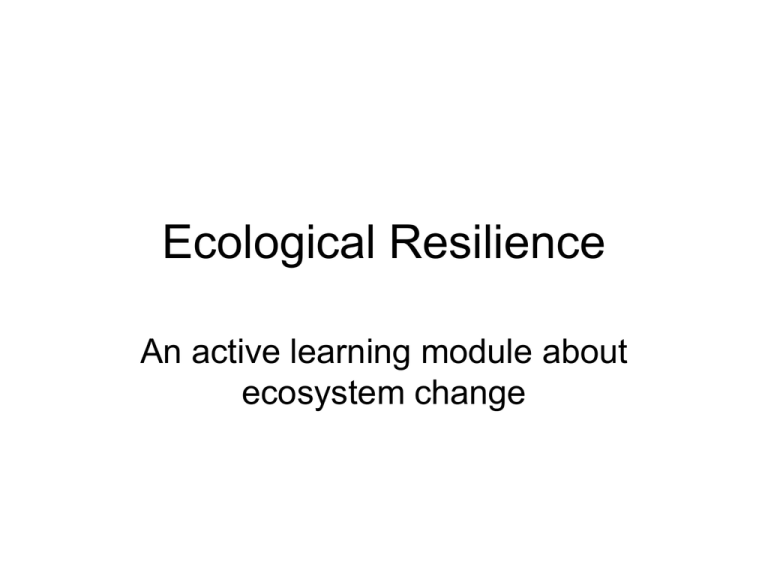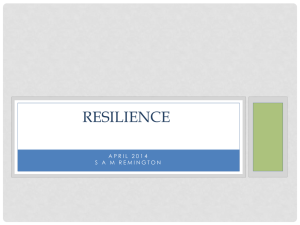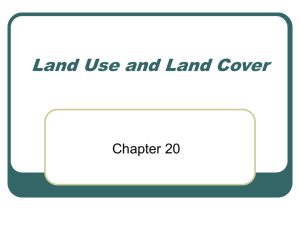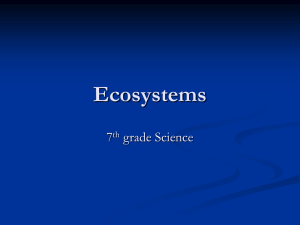Resilience Module PowerPoint
advertisement

Ecological Resilience An active learning module about ecosystem change Example Box-and-Arrow Model Excessive force: Drop, throw, smash the egg Spin the egg Egg Roll the egg Heat Hard-Boiled Egg Broken Egg System • A group of interacting or interdependent parts • Maintains its existence and functions as a whole through the interaction of its parts Your “seedpod” is a static system. Ecosystems are dynamic systems, with interactions that change over time. Resilience • The capability or degree to which an ecosystem can resist perturbation and remain within the functional boundaries that characterize it without “flipping” to a different set of functional boundaries. • The amount of change a system can undergo and remain in the same regime, retaining the same structure, function & feedbacks. Resilience and Ecosystems Resilient systems maintain both properties and processes when disturbed. A resilient “seedpod” will retain its structure AND continue to hold the ball. A resilient forest ecosystem will retain its plant and animal species AND processes of nutrient cycling and disturbance. Do these sites have different properties or different processes? Do these sites have different properties or different processes? Resilience and Response Diversity Which ping-pong ball is more vulnerable to disturbance? Response diversity increases resilience of ecosystems. Structures made out of only one material are less resilient than those made out of multiple materials. Resilience • A dynamic property of systems • Not good or bad—depends on human values – Dictatorships & eutrophic lakes highly resilient but may not be desirable from certain human perspectives • Ability of a system to recover more important than the speed of recovery – Compare popsicle sticks and pipe cleaners • Opposite of resilience = vulnerability States The state of a system is defined by the values of the state variables that constitute the system. “Seedpods” made of the same materials can be in different configurations, but the state is defined by whether the seedpod does or does not hold the ball. Ecosystems can be in different states when they have different species, or even when they have the same species but the systems function differently. Alternate States in Ecosystems • Forest: • Forest, sufficient nutrients to support regeneration • Cleared, eroded land, insufficient nutrients and soil • Rangeland: • Grassland system, nutrients evenly distributed • Shrubland, nutrient islands and barren interspace • Lake: • clear water, abundant fish • Murky water, fish die Do these sites have different properties or different processes? Do they represent alternate stable states? Threshold Point at which a system crosses into a new set of stable states. Levels of disturbance that your “seedpod” can withstand before it stops holding the ball and enters a new state where it cannot hold the ball. Thresholds in Ecosystems • Thresholds: – Lake: amount of P in sediments – Australian Rangeland: amount of grazing pressure, rainfall & fire frequency – Forest (Easter Island): amount of soil N George et al 1992 Modelling Ecosystem Change: a State and Transition Model for sagebrush & cheatgrass Relatively high diversity native plant community Native SBS Degraded SBS T1 “Improved” SBS R1 II Weedy SBS I Natural Sagebrush Steppe R2 Cheatgrass dominates, low diversity T4 T3 T2 Sagebrush eliminated via aerial spraying. Grasses dominate, low diversity. III Chemically Improved SBS Thresholds, Regimes & States • Threshold: – Levels in controlling (slow) variables where feedback to the rest of the system change – Point at which a system crosses into a new “regime” or set of stable states • Regime: – A set of states that system can exist in a still behave in the same way—have the same basic structure and function. • State: – The state of a system is defined by the values of the state variables that constitute the system. Thresholds & Alternate States • Threshold: – Lake: amount of P in sediments – Australian Rangeland: amount of grazing pressure, rainfall & fire frequency – Forest (Easter Island): amount of soil N • Alternate States: – Lake: • clear water, abundant fish • Murky water, fish die – Rangeland: • Grassland system, nutrients evenly distributed • Shrubland, nutrient islands and barren interspaces – Forest: • Forest, sufficient nutrients to support regeneration • Cleared, eroded land, insufficient nutrients and soil








